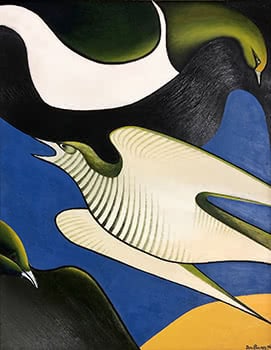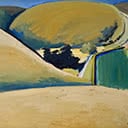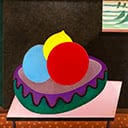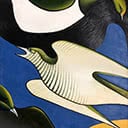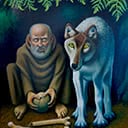Pipiwharauroa with Kereru
97.8 x 76.2 cm
est. $400,000 - 600,000
PROVENANCE
Private Collection Auckland 1963 - 2000 Fine Paintings, Photography & Prints, Webb's 28 March, 2000
Private Collection, Auckland since 2000
EXHIBITED
Don Binney - First One Man Show
The Ikon Gallery, October 15 - 27, 1963 Cat. no. 21
Don Binney is New Zealand's leading contemporary artist-ornithologist. Over the course of his career he painted many birds, contributing a body of work which was vital to the formation of our national modernism, and from which themes of conservation and environmentalism powerfully resonate.
Binney's birds are recognisable by their bright modularity; their clarity of form and tone. Appearing in rhythm with the land, they are unambiguous, elegant compositions of colour and line. Whether dominating a Northland landscape, perched on a rock or levitating above a sea horizon, they are forcefully connected to the land.
Pipiwharauroa with Kereru is a wonderful example of the artist's ability to unite land, colour, nature and form. The presence of three birds makes this a particularly special work - there are two kereru and one pipiwharauroa depicted. The shining underbelly of the latter with its bars of dark green on white is exposed to the viewer. Momentarily frozen in the fluidity of their movement, each of these three birds exists within a slightly different space.
As ever, Binney's treatment of line and colour gives this work a sense of clarity. The background modifies the form and existence of the birds, and vice versa. The bright, primary blue of the sky in this painting does not serve as a passive visual prop to the birds in the foreground, but is subsuming in its boldness. In this way, as the bodies of each bird melds with the curved lines that contain them, Binney helps guide the viewer towards an intuitive understanding of the wholeness of nature.
When it comes to artists such as Binney, it can be difficult to consider any single work in isolation. Knowledge of his practice, technique and assumptions about his broader thematic intentions draw us away from the immediacy of the work to situate it within the broader context of his oeuvre. In the case of Pipiwharauroa with Kereru, however, it is important to resist this temptation and to appreciate the specifics of this painting.
At the time Pipiwharauroa with Kereru was painted, Binney was working exclusively in oil on board. Though he later came to realise the subtleties of technique afforded by painting on canvas, the medium of board allowed him to master texture. Contrasting with the flatness of the kereru's belly is a rich, illuminated black - a sheen which he would have achieved with an oil laden, fan shaped brush. In this way, sharpness of line and gloss meets with flatness, with landmass, with movement, creating a pervading sense of harmony.
The birds in this work are not variations of a single artistic prototype, but expressions of Binney's incisive, binocular outlook on nature. The perspective in the artist's work is sometimes deliberately imperfect, and the birds in this work have been cropped to be imperfectly intact, but perfectly in motion. Between 1962 and 1963, Binney completed several other works featuring the pipiwharauroa. According to Maori mythology, it was this bird's migratory flight which inspired the journey of Maori to New Zealand.
The pipiwharauroa is a harbinger of spring, a metaphor which translates to the time when this painting was created, 1963. This was a key year in the life of the artist. It was the year of Binney's first exhibition at Ikon Gallery, the year he was married, the year he started work as an art teacher at Mount Roskill Grammar School. All in all, it is a forward looking painting of hope, interconnectedness, beauty and new beginnings.

